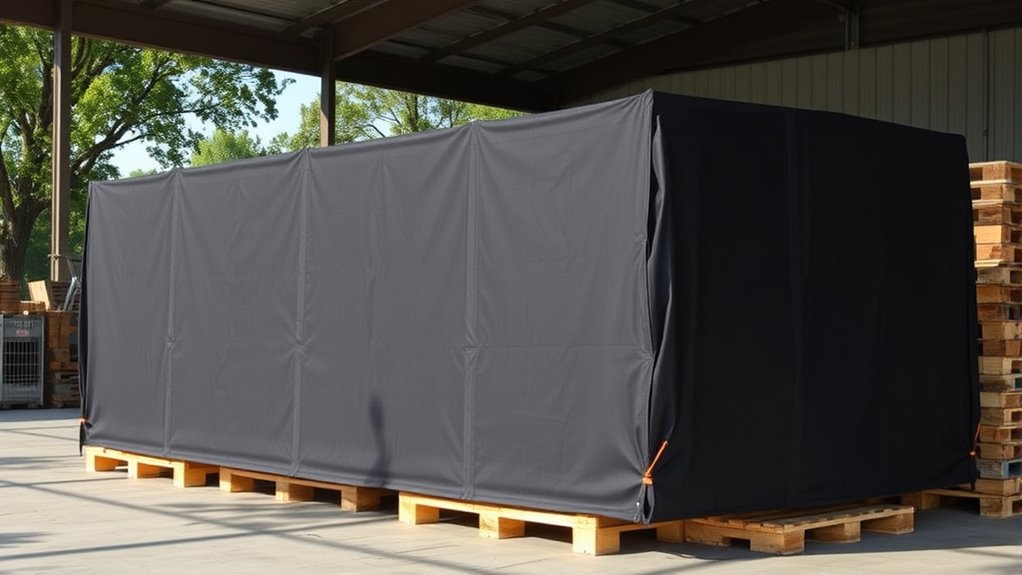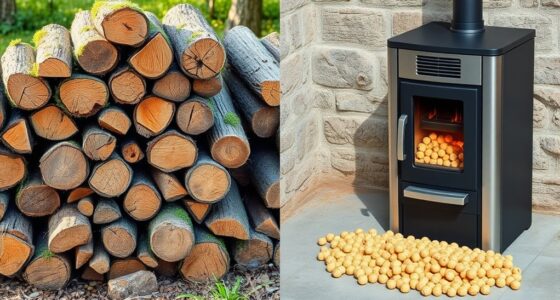To manage tarp covers without trapping moisture, guarantee proper ventilation by creating air pathways under and around the tarp using vents, grommets, or slight elevation with pallets or blocks. Use breathable materials like mesh or woven polyethylene if possible, and secure the tarp with adjustable straps rather than tight knots to allow airflow. Regularly inspect and adjust the tarp’s position, and consider moisture-absorbing materials. Knowing these techniques helps you protect assets effectively—discover more tips below.
Key Takeaways
- Use breathable tarp materials like mesh or woven polyethylene to allow moisture escape.
- Create air flow under and around the tarp with vents, grommets, and slight elevation using pallets or blocks.
- Avoid overly tight securing; maintain snug coverage that still permits air circulation.
- Regularly inspect and adjust tarp tension and positioning to prevent moisture buildup.
- Incorporate moisture-absorbing materials and keep tarps off damp surfaces for added protection.

Properly managing tarp covers is vital to guarantee they protect your assets effectively and last longer. One of the key challenges is preventing moisture from becoming trapped beneath the tarp, which can lead to mold, corrosion, and deterioration of your belongings. To achieve this, you need to pay close attention to ventilation techniques and material selection. Ventilation techniques involve creating pathways for air to circulate under and around the tarp, reducing humidity buildup. You might consider installing vents, grommets, or using a slight elevation, such as wooden pallets or blocks, to lift the tarp off the ground. This allows air to flow freely, helping moisture escape and preventing condensation from forming. Additionally, selecting a tarp made from breathable materials can naturally help reduce trapped humidity. Choosing the right material for your tarp is equally important. Not all tarps are created equal; some materials are more breathable and resistant to moisture than others. For instance, mesh tarps or those made from woven polyethylene provide better airflow compared to solid, waterproof tarps. While waterproof tarps are excellent for keeping water out, they can trap moisture if not used with proper ventilation. Conversely, breathable tarps allow moisture to escape naturally, reducing the risk of trapped humidity. When selecting your tarp, consider the environment and the specific assets you’re protecting. If you’re covering outdoor equipment in a humid climate, opting for a material with good ventilation characteristics will help maintain a dry environment. It’s also vital to ensure your tarp is properly secured without overly tight knots, which can restrict airflow and create pockets where moisture can accumulate. Using adjustable straps or bungee cords gives you the flexibility to maintain snug coverage while still allowing some air movement. Regularly inspecting and adjusting your tarp ensures that any potential moisture buildup is addressed promptly. Incorporating moisture-absorbing materials can further help in controlling humidity levels and maintaining dryness. Additionally, avoid placing your tarp directly on damp surfaces; use pallets, bricks, or other supports to keep it off the ground. According to air purifier guides, proper maintenance and ventilation are essential for maintaining air quality, which parallels the importance of air circulation in tarp management.
Frequently Asked Questions
How Often Should I Inspect My Tarp Cover for Damage?
You should examine your tarp cover at least once a month and after storms or heavy winds. Regular inspection guarantees your tarp material selection remains effective and helps catch damage early. Look for tears, loose fittings, or signs of wear that could trap moisture. By maintaining a consistent inspection frequency, you prevent moisture buildup and extend your tarp’s lifespan, keeping your coverage secure and protected.
Can I Use Any Type of Tarp for Outdoor Storage?
You can’t use any tarp for outdoor storage if you want durability. Not all tarp material selection offers the same protection—look for heavy-duty, UV-resistant tarps to withstand sun damage. UV resistance is essential to prevent cracking and fading. Choose a tarp specifically designed for outdoor use, ensuring it’s waterproof and durable. This way, your stored items stay protected, and your tarp lasts longer in harsh weather conditions.
What Are the Signs of Trapped Moisture Under a Tarp?
You’ll notice signs of trapped moisture under your tarp, like condensation droplets, a musty smell, or mold growth. To prevent this, use proper ventilation techniques such as ensuring airflow around the tarp and choosing breathable tarp material choices. Avoid airtight covers, and regularly check for moisture buildup. Properly ventilated tarps help keep your stored items dry and free from mold or rot.
How Do Temperature Changes Affect Tarp Moisture Management?
Did you know temperature swings can cause moisture issues on tarps? As temperatures fluctuate, thermal expansion occurs, which can lead to gaps or looseness, making condensation control more challenging. When it gets warmer, moisture evaporates, but cooling causes condensation that can trap moisture underneath. To prevent this, adjust your tarp tension and guarantee proper ventilation, allowing moisture to escape and reducing the risk of trapped dampness.
Are There Eco-Friendly Options for Tarp Covers?
Yes, you can choose eco-friendly tarp covers made from biodegradable tarps or recycled materials. These options reduce environmental impact and are safe for the planet. When selecting, look for tarps labeled as biodegradable or made from recycled fabrics, ensuring durability and sustainability. Using these eco-conscious tarps helps you protect your belongings while supporting environmental conservation efforts. They’re a smart, responsible choice for anyone wanting greener solutions.
Conclusion
To keep your tarp covers effective, always guarantee proper tension and ventilation to prevent moisture buildup. Remember, a well-maintained tarp can extend the life of your equipment by up to 50%. Regularly check for signs of trapped moisture, and adjust your setup accordingly. By staying proactive, you’ll avoid costly damage and keep everything dry. Protecting your assets with proper tarp management isn’t just smart—it’s essential for long-term durability.











